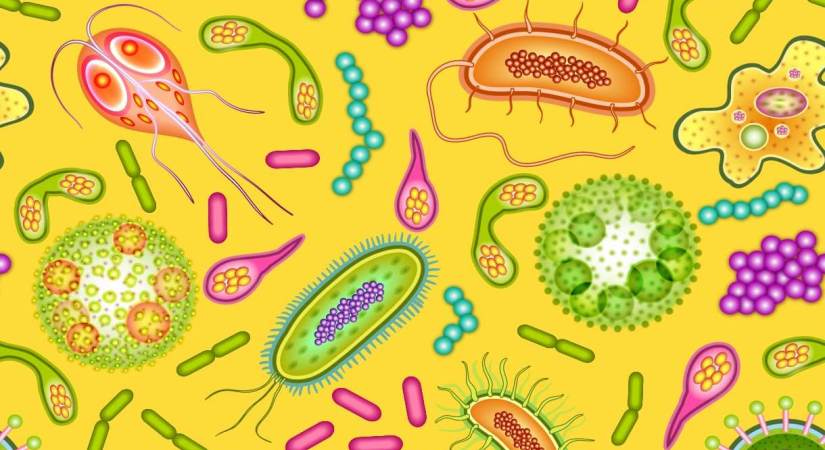Axial: https://linktr.ee/axialxyz
Axial partners with great founders and inventors. We invest in early-stage life sciences companies such as Appia Bio, Seranova Bio, Delix Therapeutics, Simcha Therapeutics, among others often when they are no more than an idea. We are fanatical about helping the rare inventor who is compelled to build their own enduring business. If you or someone you know has a great idea or company in life sciences, Axial would be excited to get to know you and possibly invest in your vision and company. We are excited to be in business with you — email us at info@axialvc.com
The "grammar" of biology refers to the underlying rules and patterns that govern the structure, function, and evolution of biological molecules like proteins and DNA. Just as human languages have grammatical rules for constructing proper sentences and conveying meaning, biology utilizes a complex set of statistical patterns that determine how biomolecules fold, interact, and carry out their roles within cells.
For decades, scientists have sought to decipher this biological grammar through painstaking experiments and analyses. By studying the sequences, structures, and activities of proteins, genes, and other biomolecules across diverse organisms, researchers have identified conserved motifs, structural domains, regulatory elements, and evolutionary relationships that shed light on the principles governing biological systems.
However, the sheer complexity and diversity of life have made it challenging to fully capture the nuances of the biological grammar using traditional approaches. Biomolecules often exhibit overlapping patterns, context-dependent behaviors, and intricate interdependencies that defy simple rules or stereotyped motifs. This is where machine learning, particularly deep learning models like protein language models, has proven transformative.
Machine learning algorithms, especially those based on neural networks, excel at identifying and modeling complex statistical patterns within large datasets. By training on vast repositories of biological sequence data, such as the Universal Protein Resource (UniProt) and the Protein Data Bank (PDB), these models can learn the intricate relationships between amino acid sequences, three-dimensional structures, and functional properties of proteins.
One of the key advantages of machine learning approaches is their ability to capture higher-order dependencies and long-range interactions that are difficult to discern through traditional methods. For example, a protein's folding and function may depend not only on local sequence motifs but also on the co-evolutionary relationships between distant residues within the sequence. Deep learning models can effectively model these intricate interdependencies, enabling more accurate predictions of structure and function from sequence data alone. Moreover, machine learning models can uncover new patterns and features that were previously unknown or overlooked by human experts. By processing vast amounts of data without preconceived notions, these algorithms can identify novel statistical regularities that may provide insights into the underlying principles governing biological systems.
In the realm of protein structure and function prediction, machine learning models like AlphaFold have achieved remarkable success by leveraging the statistical patterns present in the evolutionary relationships between protein sequences. These models can accurately predict the three-dimensional structures of proteins based solely on their amino acid sequences, a feat that was previously considered a grand challenge in computational biology. Beyond structure prediction, machine learning is also enabling the generation of novel protein sequences with desired properties, such as increased stability, altered binding specificity, or optimized enzymatic activity. By learning the "grammar" of natural protein sequences and the constraints imposed by evolution, these models can generate sequences that are statistically consistent with the biological context while exhibiting the desired functional characteristics.
Importantly, the applications of machine learning in deciphering biological grammar extend beyond proteins to other biomolecules and cellular processes. For instance, deep learning models have been employed to predict the effects of genetic variants on gene expression, unravel the complex regulatory logic governing gene regulatory networks, and identify patterns in genome evolution that shape organismal traits.
In the realm of gene expression and regulation, machine learning approaches have revealed intricate patterns in the organization of regulatory elements, such as enhancers and promoters, and their interplay with transcription factors and chromatin dynamics. By analyzing vast amounts of genomic and epigenomic data, these models can uncover statistical regularities that govern gene expression patterns across different cell types, developmental stages, and environmental conditions. Furthermore, machine learning is providing new insights into the evolutionary processes that shape genomic sequences and organismal traits. By analyzing the patterns of genetic variation across populations and species, these models can identify signatures of natural selection, gene flow, and demographic events that have shaped the diversity of life on Earth. This knowledge not only deepens our understanding of evolutionary processes but also informs efforts in areas such as conservation biology and precision medicine.
It is important to note that the success of machine learning in deciphering biological grammar is not solely due to the accumulation of large datasets or the sheer computational power available. Rather, it is the synergy between decades of biological knowledge and modern machine learning techniques that has unlocked these unprecedented capabilities.
The biological intuition and domain expertise of scientists have been instrumental in guiding the development of these models, from selecting relevant features and preprocessing data to interpreting and validating the patterns learned by the algorithms. Conversely, the ability of machine learning models to uncover novel statistical patterns has challenged and expanded our understanding of biological systems, prompting new hypotheses and avenues of inquiry. As machine learning techniques continue to evolve and biological data accumulates at an ever-increasing rate, we can expect further breakthroughs in deciphering the intricate "grammar" of biology. The integration of these powerful computational tools with experimental validation and iterative model refinement will enable a deeper understanding of the principles that govern the structure, function, and evolution of biological molecules, cells, and organisms.
Ultimately, the combination of machine learning and biological expertise holds the promise of transforming our ability to engineer and manipulate biological systems for a wide range of applications, from designing novel therapeutics and optimizing industrial enzymes to engineering synthetic biological circuits and exploring the frontiers of synthetic biology. The application of ML, particularly deep learning models like protein language models, is revolutionizing our understanding of the "grammar" of biology. By harnessing the power of statistical pattern recognition and leveraging vast amounts of biological data, these models are uncovering new insights into the principles that govern the structure, function, and evolution of proteins, genes, and cellular processes. The integration of machine learning with domain expertise and experimental validation is paving the way for a new era of biological discovery and engineering, enabling us to decipher the intricate "grammar" that underpins the remarkable diversity and complexity of life.




